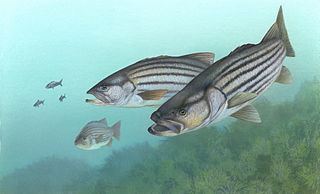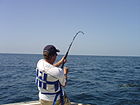
Trolling is a method of fishing where one or more fishing lines, baited with lures or bait fish, are drawn through the water. This may be behind a moving boat, or by slowly winding the line in when fishing from a static position, or even sweeping the line from side-to-side, e.g. when fishing from a jetty. Trolling is used to catch pelagic fish such as salmon, mackerel and kingfish.

Angling is a fishing technique that uses a fish hook attached to a fishing line to tether individual fish in the mouth. The fishing line is usually manipulated via a fishing rod, although rodless techniques such as handlining and longlining also exist. Modern angling rods are usually fitted with a reel that functions as a cranking device for storing, retrieving and releasing out the line, although Tenkara fishing and cane pole fishing are two rod-angling methods that do not use any reel. The hook itself can be additionally weighted with a denser tackle called a sinker, and is typically dressed with an appetizing bait to attract the fish and entice it into swallowing the hook, but sometimes an inedible fake bait with multiple attached hooks is used instead of a single hook with edible bait. A bite indicator, such as a float, a bell or a quiver tip, is often used to relay underwater status of the hook to the surface.

Sea-Doo is a Canadian brand of personal watercraft (PWC) and boats manufactured by Bombardier Recreational Products (BRP). All Sea-Doo models are driven by an impeller-driven waterjet. All Sea-Doo PWC models are produced at BRP's plants in Querétaro and Juárez, Mexico. Its Rotax engines are produced at BRP's plant in Gunskirchen, Austria. In 2016, Sea-Doo had a 45.8% share of the PWC market.

A personal watercraft (PWC), also called water scooter or jet ski, is a recreational watercraft that are designed to hold only a small number of occupants, who sit/ride or stand on top of the craft, not within the craft as in a boat.

Tow-in surfing is a surfing technique which uses artificial assistance to allow the surfer to catch faster moving waves than was traditionally possible when paddling by hand. Tow-in surfing was invented by surfers who wanted to catch big waves and break the 30 ft (9 m) barrier. It has been one of the biggest breakthroughs in surfing history.

Handline fishing, or handlining, is a fishing technique where a single fishing line is held in the hands, rather than with a fishing rod like the usual angling, of which handlining is a subtype. Handlining is not to be confused with handfishing, which is catching fish by hand. When handlining, one or more fishing lures or baited hooks are attached to the line, and a fishing lure and often a weight and/or a fishing float can also be attached to the line. Handlining is among the oldest forms of fishing and is still practiced throughout the world today.

Lake Mohave is a reservoir on the Colorado River between the Hoover Dam and Davis Dam in Cottonwood Valley defining the border between Nevada and Arizona in the United States. This 67 mile stretch of the Colorado River flows past Boulder City, Nelson, Searchlight, Cottonwood Cove, Cal-Nev-Ari, and Laughlin to the west in Nevada and Willow Beach and Bullhead City to the east in Arizona. A maximum width of 4 miles wide and an elevation of 647 feet (197 m), Lake Mohave encompasses 28,260 acres of water. As Lake Mead lies to the north of the Hoover Dam, Lake Mohave and adjacent lands forming its shoreline are part of the Lake Mead National Recreation Area administered by the U.S. National Park Service.

The SuperJet is a stand-up type personal watercraft (PWC) made by Yamaha Motor Corporation. Part of Yamaha's WaveRunner line of watercraft, it was introduced in 1990 and has become one of the most successful stand-up personal watercraft ever made. All SuperJets, including the engine, are hand-built in Japan. Credit for the design is given to Clayton Jacobson II.

Kayak fishing is fishing from a kayak. The kayak has long been a means of transportation and a means of accessing fishing grounds. Kayak fishing has gained popularity in recent times.

A fishing vessel is a boat or ship used to catch fish in the sea, or on a lake or river. Many different kinds of vessels are used in commercial, artisanal and recreational fishing.

Striped bass are perciform fish found all along the Atlantic coast, from Florida to Nova Scotia. They are of significant value as sporting fish, and have been introduced to many areas outside their native range.

Fishing techniques are methods for catching fish. The term may also be applied to methods for catching other aquatic animals such as molluscs and edible marine invertebrates.
The Sea-Doo GTX is a personal watercraft (PWC) made by Bombardier Recreational Products of Canada. Part of their Sea-Doo line of watercraft, the Sea-Doo GTX has been produced since 1992. It is a three-person personal water craft with a 'luxury' ride combined with a series of engines. The performance of a Rotax marine engine with R.A.V.E. exhaust, a three-passenger contoured seat; dual mirrors; deck pads; ski-eye; left-side forward/neutral/reverse lever; and full instrumentation.
Offshore concrete structures, or concrete offshore structures, are structures built from reinforced concrete for use in the offshore marine environment. They serve the same purpose as their steel counterparts in oil and gas production and storage. The first concrete oil platform was installed in the North Sea in the Ekofisk oil field in 1973 by Phillips Petroleum, and they have become a significant part of the marine construction industry. Since then at least 47 major concrete offshore structures have been built.
The number of personal watercraft-related accidents has increased with the popularity of personal watercraft (PWC) since their introduction during the late 1960s. The use of the term "jet ski" for all types of PWCs is a misnomer; Jet Ski is a registered trademark in the United States for a line of PWCs manufactured by Kawasaki). With the increased use of personal watercraft since their inception, the hazards accompanying their use have also increased. According to U.S. government reports, most accidents are associated with rental operators, underage operators, under-trained and undereducated boaters and a variety of factors associated with recreational-boating accidents. Due to their affordability, ease of use, and relatively low transportation and maintenance costs, personal watercraft have significantly increased the number of water-based enthusiasts in the U.S. This rise in participation has created conflicts between the various boating segments in the U.S. and a need for additional boater education. Recreational-boating accidents are the second-largest transportation-related cause of injury in the U.S..

K38 Water Safety teaches public and federal safety agencies such as lifeguards, military, fire rescue, and law enforcement how to operate personal water craft (PWC), Jet Skis, Kawasaki Heavy Industries, Waverunners, Aquatrax, PWC or RWC. K38 teaches personal water craft rescue training in swiftwater rescue, big wave surfing, tow-in surfers, law enforcement, lifesavers, and federal agencies such as United States Navy, United States Marines, United States Coast Guard, U.S. Border Patrol BORSTAR units and Pararescue.
Burton "Buzzy" Kerbox is an American surfer, photographer and model. He is best known for co-developing tow-in surfing with Laird Hamilton, Dave Kalama and a handful of other surfers in the mid-1990s.

Fishing in Egypt includes every form of fishing as a hobby or professional nowadays. In Egypt, fishing is really developed and the country is considered one of the best fishing destinations in the world.

Franky Zapata is a French personal watercraft pilot who is the inventor of the Flyboard and Flyboard Air, and founder of Zapata Racing. Since 2012, Zapata's efforts have been focused on the development and manufacture of personal flyers for land and aquatic applications.
















